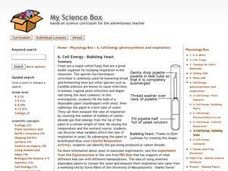Curated OER
Cup Capacity Tool: Measuring Cup
Students examine containers and their capacity. They fill a one-cup measuring cup with water and pour cups of water into other containers. Through observation, students discover how many cups make a pint, and how many teaspoons make a...
Curated OER
Cooking Fun
Young scholars explore a variety of methods for the measurement of dry, semi-solid, and liquid ingredients. Real kitchen utensils and food items are utilized in this lesson plan.
Curated OER
Measuring pH
Pupils perform an experiment which will illustrate how to measure the approximate pH of chemicals in water using a pH indicator. They understand that a pH indicator is a chemical that changes color when it comes in contact with acids or...
American Chemical Society
Solubility Test
Make sure to consult the teacher's handbook, Inquiry in Action - Investigating Matter Through Inquiry, for two demonstrations that can be done to introduce solubility and measuring crystal mass before having the class conduct this...
American Chemical Society
Change in Temperature - Endothermic Reaction
Now that learners have been exposed to chemical changes, they learn that some take in heat and therefore, decrease in temperature. The same reaction that they have been investigating between baking soda and vinegar is revisited,...
Baylor College
We Need Water
There's nothing quite like a glass of ice-cold, freshly squeezed lemonade. Lesson seven of this series explains how the water humans need to survive can come in many forms. Teach your class about how much water humans require every day...
Curated OER
Microbes
Microbiology beginners feed different sweetening agents to yeast and measure carbon dioxide production to estimate energy contained in each. They set the trials up in zip-top plastic baggies and then measure gas volume by water...
Curated OER
Volumw Measurement, English System
Eighth graders biew each volume container and discuss where they have seen them in their home, and how they have seen them used. They explore the different names of volume sizes and their equivalents towards one another. Students...
Curated OER
By the Pound, Gram Liter or Gallon
Students participate in experiments at five stations to practice measurement. In this measuring lesson, students are presented different produce and objects and must measure with an appropriate tool. Students use metric and customary...
Curated OER
Second Servings
Second graders understand the appropriate sizes for food portions. In this food groups lesson, 2nd graders create and measure a meal using correct portion sizes and correct measurements.
DiscoverE
Make Your Own Glue
You won't regret being stuck with this activity. By mixing a variety of household items, pupils create their own glue. They test the tensile strength of their glue and compare it to that of other adhesives.
Curated OER
Sampling Carbon Dioxide
Students perform an experiment to determine which source of gas (their breath, exhaust from a car, or the air in the classroom) has a greater concentration of carbon dioxide. Students compare the colors of BTB solutions after...
Curated OER
Cell Energy - Bubbling Yeast
Students identify that yeast are a single celled fungi that are a great model organism for studying respiration in the classroom. They also fill the bulb of a disposable pipet (eyedropper) with yeast, then submerge the pipet in a test...
Curated OER
Types by Texture: Soil Isn't a Dirty Word
Second graders experiment with different types of soil to find the texture. In this types of soil experiment, shake a jar of soil and water and record the settling of the soil. Students record again after 3-4 hours and note the level...
Curated OER
Determining The pH Of Common Substances
Learners use a pH indicator to measure the pH of some fruits, common beverages, and borax. Students discover how to differentiate between an object that is an acid or a base.
Curated OER
Where Did the Water Go? An Investigation in Scientific Methods
Middle schoolers view a teacher demonstration that prompts them to solve a problem using the scientific method. In this scientific method activity, students guess which cup has water and are presented with a conundrum when the water does...
Curated OER
What is the Mantle Like?
In these earth science worksheets student complete this project to model activity in the mantle, one Earth's four layers. The project includes liquid and powder materials in addition to several measuring components. Students must then...
Curated OER
How to Float an Egg
Use the scientific method to experiment with an egg. Your class can examine buoyancy and density by finding how many spoons of salt are needed to float an egg. They can predict, experiment, record data, and analyze results.
American Chemical Society
Exothermic, Endothermic, and Chemical Change
Scientists can't observe bonds breaking or forming, so how do they distinguish between exothermic and endothermic reactions? Young scholars complete two experiments to do just that. They monitor temperature change and calculate the...
Oregon Museum of Science and Industry (OMSI)
DNA Extraction
What does your DNA actually look like? Use simple materials with this experiment to find out! Geneticists of all ages can follow these instructions to extract their own DNA. For learners who are hoping to extend the activity, there are...
Curated OER
Do What You Water: Natural Inquirer
Students investigate water resources on Earth by reading a science magazine. In this natural resources lesson, students read an article in the Natural Inquirer dealing with the scarcity of fresh water. Students complete a survey...
Curated OER
The Effect of Temperature on Solubility
In this solubility worksheet, students conduct an experiment to see how temperature effects the solubility of salt in water. Students record their data in a chart and then graph the results. Then students complete 2 short answer questions.
Curated OER
Amazing Salt
Students examine the effects of salt on ice. In this salt lesson, students observe what happens to the temperature of ice when salt is added, then make ice cream to see how this knowledge can be used.
Curated OER
Hunting for Aqueous Solutions
In this aqueous solutions learning exercise, students will conduct an experiment to determine the solubility of different common kitchen items. Students then complete 3 short answer questions.

























